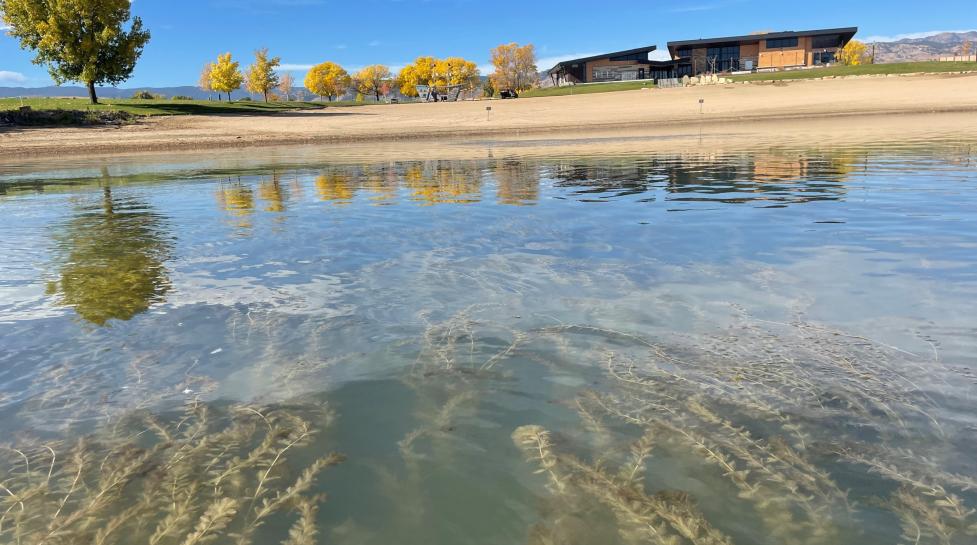In summer 2022, Colorado Parks and Wildlife detected Eurasian watermilfoil (EWM), an invasive plant, in the Boulder Reservoir. Since then, EWM has become established in the Reservoir. Northern Water and the city hired a subject-matter expert in aquatic nuisance species to develop an adaptive management plan and recommend management options, which include using a targeted herbicide within the next year to manage EWM’s spread and minimize its impacts.
In summer 2022, Colorado Parks and Wildlife detected Eurasian watermilfoil (EWM), an invasive plant, in the Boulder Reservoir. Since then, EWM has become established in the Reservoir. It has spread significantly in the western coves and the swim beach, impacting boating and swimming. If it continues to spread, EWM may also impact the 63rd Street Water Treatment Plant intake, a backup water supply for the City of Boulder, and the Boulder Creek Supply Canal outlet, which Northern Colorado Water Conservancy District (Northern Water) uses to deliver water to downstream users.
Northern Water and the city hired a subject-matter expert in aquatic nuisance species to develop an adaptive management plan and recommend management options, which include using a targeted herbicide within the next year to manage EWM’s spread and minimize its impacts. Working with a licensed herbicide applicator, Northern Water and the city will create a targeted herbicide application plan to inform how to move forward with treatments on an as-needed basis.
The selected herbicide will be triclopyr, because it is effective and has the fewest impacts to water quality. It is already used by Northern Water in areas adjoining the Boulder Feeder Canal upstream of the Reservoir. Triclopyr was reviewed and approved for targeted EWM control in the Boulder Reservoir by the city’s Integrated Pest Management program.
“EWM impacts the Reservoir in many ways, including wildlife habitats, water quality, and recreational swimming and boating,” said Parks and Recreation Director Ali Rhodes. “Since it has become established, eradication is now unlikely, and we are working hard with partners to take care of this important water resource”
“Triclopyr’s use poses minimal risks to water quality and irrigation, and can be managed through city operational protocols, concentration thresholds, application areas and timing,” said Director of Utilities Joe Taddeucci. “We’re looking to start its application in spring 2025, although this may be re-evaluated pending the conditions of EWM in the Reservoir.”
Once Northern Water and the city have a final application plan, they will evaluate and track triclopyr’s effectiveness on EWM to determine future, targeted applications, with the goal of reducing its use over time. The city will continue to pull EWM by hand near the swim area and near water intakes and outlets to protect public safety, water operations, and recreation use. The city and Northern Water will continue to evaluate long-term strategies that limit the use of herbicide.
City staff will also continue to manage established EWM through the existing watercraft inspection and decontamination program, visitor education, and prohibiting the possession and launching of watercraft in all surrounding areas except the designated recreation area on the South Shore.
“Our goals are to continue to have the Reservoir be a safe water storage facility for the city and region and safe place for our community to play,” said Rhodes.
The city will continue to manage the established EWM by:
- Continuing the existing watercraft inspection and decontamination program, which includes inspecting large watercraft, and small watercraft as allowed, entering and exiting the Reservoir.
- Encouraging all visitors to follow a “Clean, Drain, and Dry (PDF)” practice to confirm that they are not transporting EWM to or from the Reservoir.
- Educating visitors about EWM, including those recreating on the North Shore.
- Maintaining the ban on possessing or launching watercraft from all areas other than the designated South Shore recreation area. Anyone with watercraft or a flotation device in these areas including around Coot Lake will be issued a summons with a potential fine.
- Maintaining the closure on the west side of Boulder Reservoir
- Conducting routine vegetation surveys and partnering with CPW to assess any changes in EWM.
Additional information about EWM, the city’s ANS protocols, and triclopyr application logistics can be found at bouldercolorado.gov/aquatic-nuisance-species.
Keep Reading
News keep reading
-
City of Boulder Parks and Recreation Department (BPR) Receives National Accreditation for Outstanding Service
-
Recreate Responsibly in and Around Boulder's Natural Bodies of Water
-
Let’s DOO It! DOO Your Part to Keep Shared Public Land Beautiful
-
Parks and Rec Director’s Column: Build Together, Play Together
